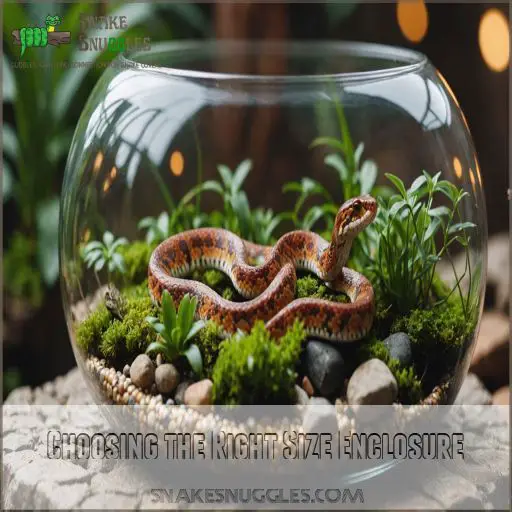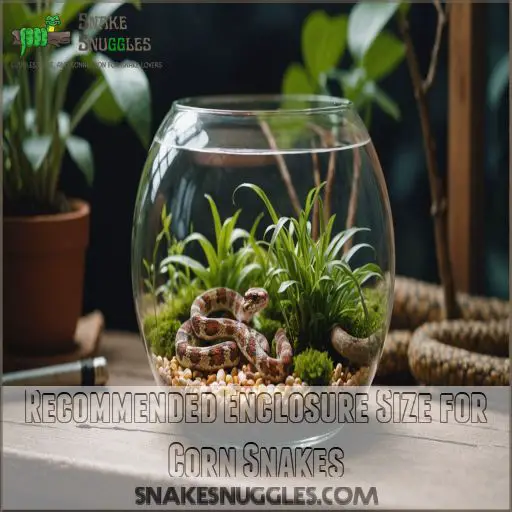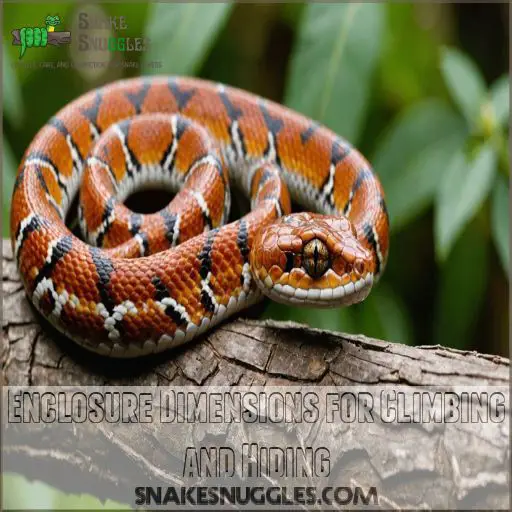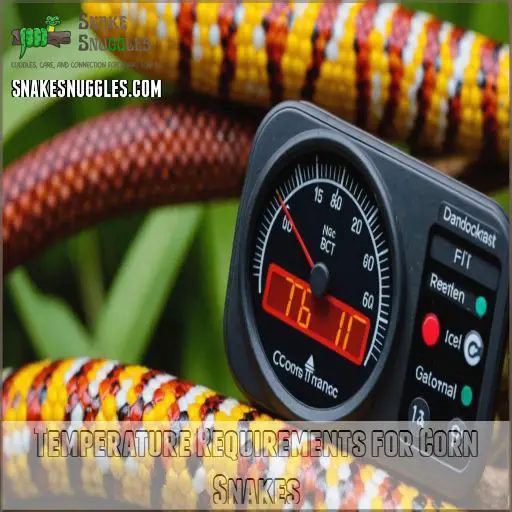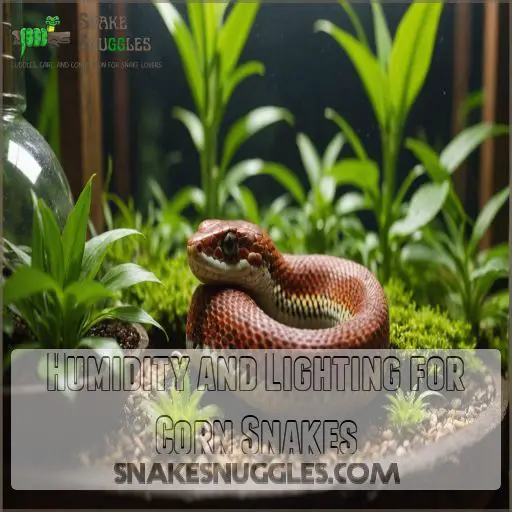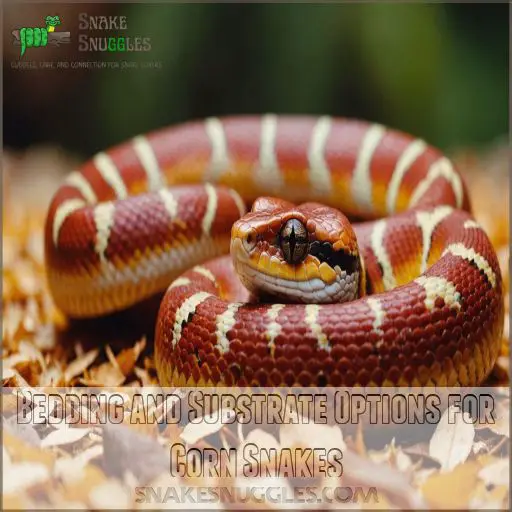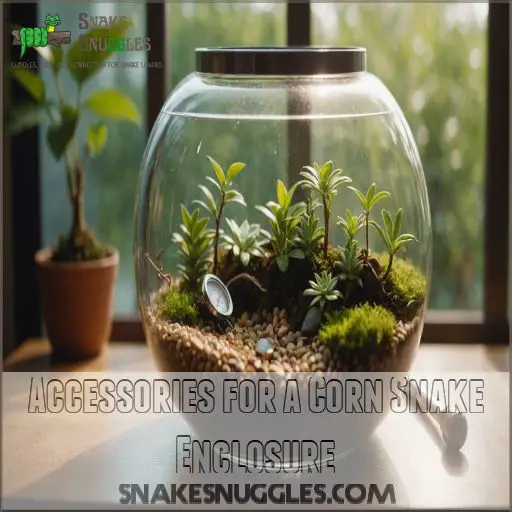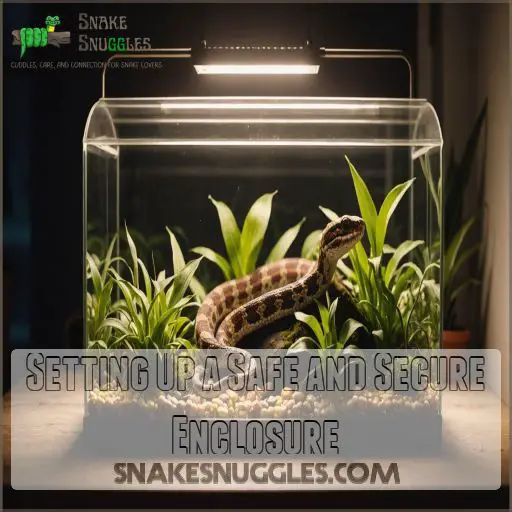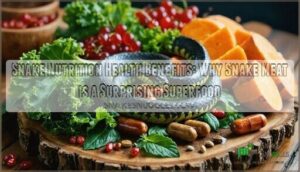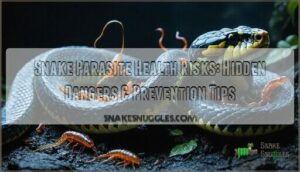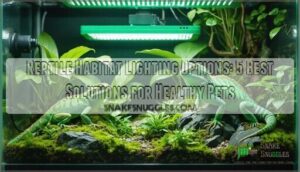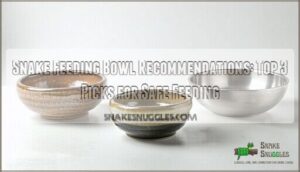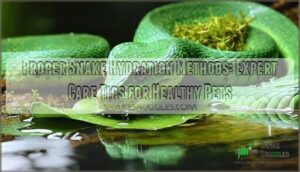This site is supported by our readers. We may earn a commission, at no cost to you, if you purchase through links.
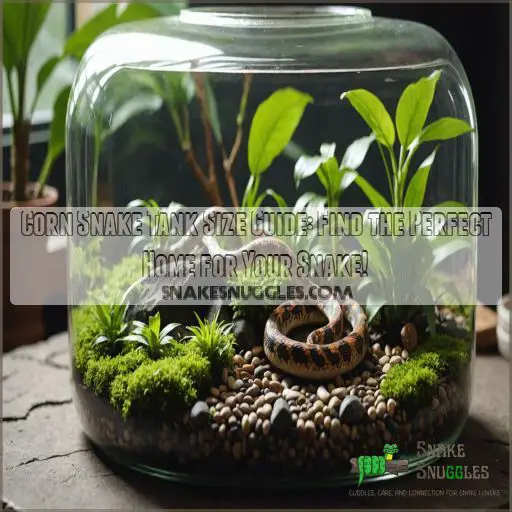 Choosing the right corn snake tank size makes sure your slithery friend has a comfy home. As a rule of thumb, the enclosure’s length and width should at least match your snake’s length—kind of like buying shoes that fit!
Choosing the right corn snake tank size makes sure your slithery friend has a comfy home. As a rule of thumb, the enclosure’s length and width should at least match your snake’s length—kind of like buying shoes that fit!
Start your young snake in a 10-gallon tank but plan for a 40-75 gallon for adults.
Enclosures that are 48"x24"x24" make cozy habitats, offering space for exercise and relaxation. Larger spaces reduce stress and promote a healthier lifestyle—because even snakes appreciate room to stretch out!
Curious about creating the perfect stress-free oasis for your snake? Keep reading to discover more tips!
Table Of Contents
- Key Takeaways
- Choosing the Right Size Enclosure
- Recommended Enclosure Size for Corn Snakes
- Enclosure Dimensions for Climbing and Hiding
- Temperature Requirements for Corn Snakes
- Creating a Thermal Gradient in the Enclosure
- Humidity and Lighting for Corn Snakes
- Bedding and Substrate Options for Corn Snakes
- Accessories for a Corn Snake Enclosure
- Setting Up a Safe and Secure Enclosure
- Frequently Asked Questions (FAQs)
- How big of a tank does my corn snake need?
- Is a 20 gallon tank enough for a corn snake?
- Can a corn snake live in a 40 gallon tank?
- Can a corn snake live in a 25 gallon tank?
- How frequently should you clean a corn snake tank?
- What type of heating is safe for corn snakes?
- Can corn snakes be housed with other pets?
- How do you prevent a corn snake escape?
- What is the optimal diet for corn snakes?
- Conclusion
Key Takeaways
- You’ll want to size up your corn snake’s home as it grows – think of it like upgrading from a starter apartment to a spacious house, especially as they reach full size. Start hatchlings in a cozy 10-gallon tank, but plan to move adult snakes into a roomy 40-75 gallon enclosure (about 48"x24"x24") so they can slither and stretch to their heart’s content.
- When picking out your snake’s pad, remember this golden rule: the length and width of the enclosure should add up to at least your snake’s total length. It’s like buying shoes that fit – you wouldn’t want your scaly friend to feel cramped!
- Don’t skimp on the vertical space – corn snakes are secret acrobats! Aim for at least 24 inches of height so your snake can indulge its inner tree-climber. Think of it as giving your snake its own personal jungle gym.
- Creating a thermal gradient in your snake’s home is crucial – it’s like setting up a snake spa with different temperature zones. Use a combination of heat lamps and under-tank heaters to create a warm basking area (82-85°F) and a cooler retreat (75-80°F), letting your snake choose its perfect chill spot.
Choosing the Right Size Enclosure
Finding the perfect enclosure size for your corn snake involves some simple math and a bit of common sense, considering optimal tank dimensions
.
You’ll want to make sure your scaly friend has enough room to stretch out and play without feeling cramped, so think of it as picking the right pair of pants—comfort and style matter!
Minimum Floor Dimensions for Corn Snakes
When deciding on the right tank size for your corn snake, consider a 40-gallon glass enclosure for adults, as recommended in this corn snake tank setup. When deciding on an enclosure footprint for your corn snake, remember this golden rule: make sure the length and width add up to the snake’s length.
Their habitats require a suitable length-to-width ratio to accommodate growth potential and meet space requirements.
Calculating the Ideal Enclosure Size
To determine the ideal corn snake enclosure, simply multiply the snake’s length by 0.7 for the length and 0.5 for the width. This gives your slithery friend plenty of space to thrive!
Considering the Snake’s Current and Adult Size
As your corn snake grows, think of it like upgrading from a starter home to a dream house.
Long-term planning saves headaches.
Make sure future space requirements include room for substrate changes, from aspen shavings to cypress mulch, accommodating its evolving needs.
Recommended Enclosure Size for Corn Snakes
Finding the right tank size for your corn snake is important to its health and happiness, as explained in the corn snake care guide.
While some may think a cozy space is enough, these curious snakes will thrive in environments where they can stretch out and explore like the Indiana Jones of the reptile world!
Absolute Minimum Recommended Enclosure Size
When choosing an enclosure, it’s important to make sure your corn snake has plenty of space for safety and comfort.
The absolute minimum size should be 48"x24"x24", offering enough room for a basking spot, water bowl, and heating attachments.
Benefits of Larger Enclosures
Larger enclosures offer corn snakes more space to thrive. They can reduce stress, encourage natural exploration, and promote better muscle tone and overall health. Plus, extra room lets your snake feel safe and secure in its new home.
Stress reduction
- Stress reduction
- Exploration space
- Health benefits
Enclosure Size for Babies and Yearlings
You’ve seen the benefits of larger spaces, but baby snakes and yearlings need special care.
Start tiny critters in ten-gallon tanks to match their growth.
As they mature, move them to 30×12 enclosures—like turtle doves outgrowing small nests.
Enclosure Dimensions for Climbing and Hiding
When setting up your corn snake’s enclosure, make sure there’s enough room for both hiding and climbing to help them thrive, like those growth factors that influence their size.
After all, even snakes need a place to do their sneaky ninja moves and a cozy corner to practice their best “I’m not here” impression!
Providing Adequate Climbing Space
Picture your corn snake exploring like it’s hiking in North America’s rocky areas.
Include climbing branches and sturdy vertical decor in a vision cage to mimic nature.
Enclosure height matters!
Make sure branch thickness supports safe climbing adventures without wobbling.
Importance of Hiding Spots
Corn snakes have a strong predator avoidance instinct, so providing ample hiding spots in their enclosure is essential.
Strategically place secure hides on both the warm and cool sides to help your snake feel safe and secure.
Recommended Enclosure Height
Don’t forget the vertical space when setting up your tank. Corn snakes love climbing branches, so opt for a tall tank. Think of it as their jungle gym! An enclosure height of at least 24 inches keeps your snake happy and active.
Temperature Requirements for Corn Snakes
When you’re setting up your corn snake’s enclosure, think of the temperature as their personal thermostat—too hot, and they’re roasting; too cold, and you’ve got a chilly willy.
Aim for the Goldilocks zone with a warm side of 82-85°F for basking and a cool side around 75-80°F, ensuring your scaly friend feels just right all day.
Hot and Cool Side Temperatures
Creating a cozy nook for your corn snake involves setting the right temperature zones. The warm side should be 82-85°F, while the cool side needs 75-80°F, ensuring a perfect thermal gradient for your slithering buddy.
- Heat lamp placement matters.
- Aim for excellent thermal regulation.
- Select an appropriate heat pad size.
Basking and Nighttime Temperatures
During the day, your corn snake will thrive in a toasty 85-88°F basking zone.
But as night falls, temperatures can comfortably dip to a cool 72-75°F to mimic their natural habitat.
| Time of Day | Temperature Range |
|---|---|
| Daytime | 85-88°F |
| Nighttime | 72-75°F |
Heating Elements for Corn Snakes
When you’re thinking about warming your corn snake’s home, you want a safe heating setup that mimics sun-dappled warmth. Consider these heating solutions:
- Ceramic heat emitter: Long-lasting and efficient.
- Heat pad wattage: Use a thermostat controller.
- Heat lamp alternatives: For varied options.
- Thermostat control: Makes sure the temperature is consistent.
Creating a Thermal Gradient in the Enclosure
Creating a thermal gradient in your corn snake’s enclosure is important to keeping your slithery friend happy and healthy, and it’s a key part of setting up the perfect corn snake habitat.
Imagine your snake doing the limbo between a balmy beach and a cool cave, using a heat lamp and under-tank heater to master this cozy reptilian dance.
Using a Heat Lamp and Under Tank Heater
Crafting the perfect thermal gradient for your corn snake’s habitat means positioning a heat lamp on one side and an under-tank heater on the other.
With the correct heat lamp wattage, you create the perfect cozy zones for basking and chilling.
Monitoring Terrarium Temperatures
To monitor your corn snake’s temperatures, strategically place Zoo Med thermometers on both the hot and cool sides.
This allows you to fine-tune the thermal gradient and make sure the nighttime cooling is just right.
Avoiding Hot Rocks
Imagine your corn snake as a sunbather; avoid the risky "hot rock" tanning accidents! Hot rock dangers include burn risks, so craft a safe basking experience with alternative heating like lamps. Maintain a thermal gradient to make sure your snake’s comfortable.
Humidity and Lighting for Corn Snakes
Keeping your corn snake cozy involves managing humidity and lighting just right.
Whether it’s using a trusty mist bottle or stepping up your game with a fancy automatic mister, you’ll keep your slithery friend shedding smoothly.
Possibly even glow with a bit of UVB lighting!
Maintaining Proper Humidity Levels
Humidity levels are really important for your snake’s health and shedding.
Aim for around 50%.
A water bowl, and a suitable substrate that retains moisture, can help.
Creating a mini rainforest isn’t necessary, but do keep things snug and comfy!
Using Automatic Misters and Hand Misting
Although automatic misters can simplify humidity maintenance, hand misting allows you to monitor your corn snake’s needs more closely for the rare albino morph. Plus, a damp Repti Shelter can aid shedding when humidity is just right.
- Automatic misters provide consistent humidity
- Hand misting lets you customize moisture levels
- Damp Repti Shelter helps with healthy sheds
Benefits of UVB Lighting
You’ll light up your corn snake’s life with UVB lighting! It’s like a sunny spa day, promoting Vitamin D3 synthesis for bone health, supporting vibrant color enhancement, aiding in shedding, and boosting overall well-being. A bright idea, right?
Bedding and Substrate Options for Corn Snakes
Choosing the right bedding for your corn snake’s enclosure is essential for their comfort and health, acting like a cozy carpet that helps regulate humidity and create a good basking spot, just like the safe, hygienic substrate mentioned in the care guide.
Easy-to-clean materials, like eco-friendly aspen or tropical jungle mix, are ideal so your slippery buddy always has a fresh and inviting space.
Recommended Bedding Materials
Choosing the right bedding for your corn snake is important for their comfort and safety.
Options like Zilla Jungle Mix or Zoo Med Aspen are great substrates.
Aim for a 2-3 inch layer to provide a good bedding depth and ease of maintenance.
Spot Cleaning and Changing Bedding
Spot clean the bedding after your corn snake’s potty breaks, and change the full substrate about once a month. Try Zilla jungle mix, eco earth, or aspen for easy-to-clean options that keep your snake’s home fresh.
- Spot clean bedding after defecation.
- Change bedding completely about once a month.
- Use easy-to-clean substrates like Zilla jungle mix, eco earth, or aspen.
Disinfecting the Enclosure
Now that you’re a whiz at bedding changes, let’s tackle enclosure cleaning.
Whip out your vinegar and water mix for monthly disinfecting.
Keep it safe: avoid harsh chemicals.
Consistent maintenance offers a pristine habitat for your scaled buddy.
Accessories for a Corn Snake Enclosure
When setting up your corn snake’s home, remember that a cozy hideaway and a lockable lid are like a comfy blanket and a secure door—they’re essential!
Don’t forget to add a thermometer and hygrometer to keep your snake’s environment just right, because nobody likes a cold or stuffy house, not even snakes!
Providing a Secure Hiding Place
Pleasant bedding choices lay the groundwork, but now, let me tell you about hiding spots. Having a cozy nook, like a Zoo Med’s Habba Hut or Cork Bark, can reduce stress. Snakes enjoy snug, dark places, putting them at ease.
Choosing a Lockable Sliding Screen Lid
A lockable sliding screen lid is essential for your corn snake’s safety and security. This durable material allows proper ventilation while preventing unwanted escapes. Prioritize this key enclosure feature for your slithery friend’s wellbeing.
- Safety
- Security
- Ventilation
- Durability
Using a Thermometer and Hygrometer
Want to make sure your corn snake feels cozy? A good thermometer and hygrometer combo can be your best friend! Monitor temperature accuracy and humidity control effortlessly. Don’t let pesky calibration or troubleshooting issues get you hot under the collar!
Monitor temperature accuracy and humidity control effortlessly.
| Tool | Function |
|---|---|
| Thermometer | Temperature accuracy |
| Hygrometer | Humidity control |
| Calibration | Troubleshooting |
| Monitoring | Analyze changes |
Setting Up a Safe and Secure Enclosure
Creating a safe and secure enclosure for your corn snake is as important as locking the cookie jar from a midnight snack raid—vital for their well-being!
Escape-proof and sturdy, your snake’s home needs to be equipped with all the essentials to keep your sly friend happily contained.
Avoiding Escape-Proofing Issues
When setting up your corn snake’s home, make sure it’s escape-proof! Prioritize:
- Enclosure security: Use strong locks and check the lid.
- Lid security: A sliding screen lid is a must.
- Escape-proof methods: Seal any small gaps.
- Ventilation issues: Maintain airflow without sacrificing security.
Ensuring a Secure and Sturdy Enclosure
Make sure your corn snake’s enclosure is sturdy and secure with a lockable sliding screen lid. Choose durable, escape-proof materials to prevent accidents and keep your slithery friend safely contained.
Creating a Safe Environment for Your Corn Snake
Let’s create a safe haven for your corn snake. Focus on these three aspects to keep things spick and span:
- Enclosure security: Tighten those latches!
- Plenty of hiding spots: Privacy is important.
- Substrate safety: Avoid toxic materials.
Frequently Asked Questions (FAQs)
How big of a tank does my corn snake need?
Your corn snake needs a tank that’s at least 48 inches long, 24 inches wide, and 24 inches tall. This spacious setup’ll let your slithery friend stretch out and explore comfortably. (Source)
Is a 20 gallon tank enough for a corn snake?
A 20-gallon tank for a corn snake is like putting a giant in a dollhouse!
These curious explorers thrive in larger spaces; for good health, an adult snake needs at least a 36" x 18" enclosure.
Can a corn snake live in a 40 gallon tank?
A 40-gallon tank is an excellent choice for your corn snake!
It’ll provide ample space for climbing, exploring, and setting up cozy hides.
Your slithery friend will thrive in this roomy abode, living its best snake life.
Can a corn snake live in a 25 gallon tank?
Ever wondered if a cozy 25-gallon tank is enough for your slithery friend?
While it’s not ideal, a corn snake can survive in this space.
You’ll want to upgrade as they grow for their comfort and well-being.
How frequently should you clean a corn snake tank?
Clean your corn snake’s tank weekly by spot-cleaning droppings and uneaten food.
Deep clean monthly, replacing all substrate and disinfecting surfaces.
Regular maintenance helps create a healthy habitat and a happy, slithering companion.
What type of heating is safe for corn snakes?
Like a cozy fireplace warms your home, safe heating keeps your corn snake comfy.
Use a basking light and under-tank heat pad on the hot side.
Avoid hot rocks; they’re risky.
Monitor temps with reliable thermometers for a happy, healthy snake.
Can corn snakes be housed with other pets?
You shouldn’t house corn snakes with other pets.
They’re solitary creatures and mixing species can lead to stress, injury, or even predation.
Keep your scaly friend solo for their safety and well-being.
It’s the slithery way to go!
How do you prevent a corn snake escape?
Imagine your corn snake as Houdini in scales.
To prevent escapes, make sure your enclosure has a secure, lockable lid.
Seal any gaps, choose the right substrate depth, and double-check latches.
It’s better to be safe than sorry!
What is the optimal diet for corn snakes?
Feed your corn snake appropriately-sized mice or rats once a week.
Offer frozen/thawed rodents for safety.
Hatchlings need pinkies, juveniles enjoy hoppers, while adults can handle small rats or adult mice.
Always provide fresh water.
Conclusion
Like a tailor crafting the perfect suit, choosing the the right corn snake tank size is an art.
By following this guide, you’ll create a cozy castle for your scaly friend.
Prioritize proper heating, humidity, and hiding spots to keep your snake happy and healthy.
With the right setup, your corn snake will thrive in its new home.
So go ahead, give your slithery companion the royal treatment it deserves!

